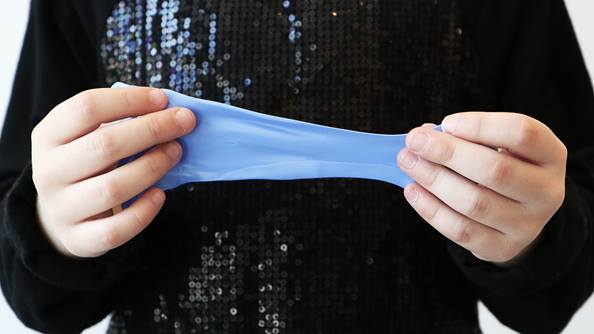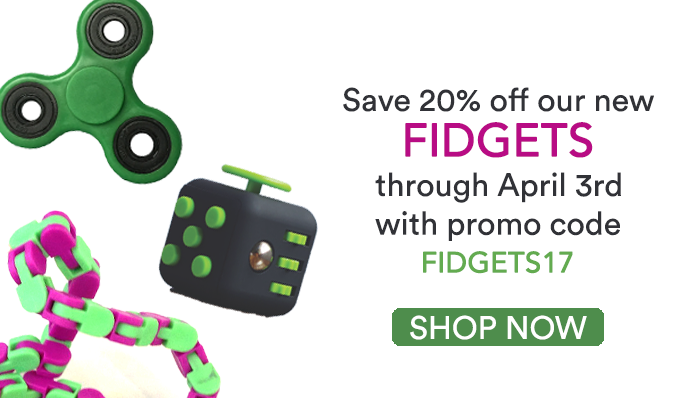This week, Linda Hodgdon, M.Ed., CCC-SLP shares her thoughts on the rising popularity of fidget spinners. This piece originally appeared on her blog at www.usevisualstrategies.com.
OK. . .so I got 5 fidget spinners for 5 grandchildren. Amazingly, there were 5 colors available so there would be no confusion over which spinner belonged to which child.
Then BAM. . .
School banned them!
No fidget spinners in school!
Well. . . .can you guess my immediate reaction?
Why not teach the students the correct way to use them? My logic says that would be a good goal. But obviously that school staff didn’t look at it with my logic.
Are fidget spinners a distraction or a learning tool?
I guess that depends on how you use them. It’s just like technology. Tech tools can be a huge helper for students or they can become an obsession for games and activities that cause students to hyper focus so they miss what’s important to pay attention to.
This is not just an autism thing. It’s also an ADHD thing. And a typically developing young child thing. Older kids, too. And don’t forget adults.
The internet has information
I’ve read a number of internet articles telling how wonderful fidget spinners are, but there seems to be more information about what’s bad. Here are examples.
- A young child took the fidget spinner apart and accidentally swallowed pieces when he put them in his mouth. Surgery needed.
- Some adults are concerned because spinner parts may have mercury or lead. Health hazard.
- Teachers react to how disruptive spinners are in class.
But this complaint is most interesting
It’s written by young woman on the spectrum. She shares how students who need to stim in order to concentrate have endured years of training to have “Quiet Hands” or demonstrate other “normal” behaviors. Now, all of a sudden, a businessman writes about being able to concentrate better at staff meetings with a fidget toy. She concludes,
“Something that was considered entirely pathological and in dire need of correction when done by disabled people is now perfectly acceptable because it is being done by non-disabled people.”
Good point
Makes me think how some describe autism “behaviors” as meaningful and typical, but just occurring more frequently or intensely than those without autism might do.
One point worth considering
In defense of the teachers out there, I’m thinking of the “criteria” for a good fidget toy. I’ve listed them out in my speaking programs. For example:
- Small enough to fit in your hand or pocket
- Doesn’t make noise
- Not distracting to others
- Doesn’t bounce
- Has movement or texture or something that will engage the hand of the individual
Fidget spinners fall short for some of my criteria even though they rate very high on social interest.
Are there other options?
The problem with fads is that they go out as fast as they come in. I’ll bet that by the time the new school year starts in the fall, fidget spinners will be lying in the bottom of a drawer somewhere and there will be a new fad for a new school year.
What is your experience with fidget spinners or other fidget toys? I’d love to hear. Just click below or comment on my Facebook page.
https://www.facebook.com/lindahodgdon.autism
About The Author
Linda Hodgdon, M.Ed., CCC-SLP is a Speech-Language Pathologist who is internationally known as a pioneer in developing the use of visual strategies to support communication for students with the communication, behavior or social skill challenges that are common in Autism Spectrum Disorders (ASD).
As an author, speaker and consultant, she has become well known world wide for her very practical information and strategies that guide communication partners to develop effective communication relationships with their children with autism.
With a focus on communication, Linda’s books and training programs are packed with “best-practices” and proven strategies for helping individuals from young children with autism through adults with Asperger’s participate more effectively in their life opportunities.



 Fidget toys can be a great and socially acceptable replacement for stereotypic or repetitive behavior in the classroom or community. Some students find the repetitive action of “fidgeting” to be calming and are then better able to focus on the task at hand. Additionally, some students who have a difficult time staying still are able to sustain sitting behavior for longer periods with less support or prompting when they are manipulating something repeatedly in their hands. We’ve included a variety of items that vary in texture or are manipulated in different ways so that they can be rotated regularly. The components have also been chosen so that they can be worn on the wrist, clipped to a belt, handheld or attached to a piece of clothing.
Fidget toys can be a great and socially acceptable replacement for stereotypic or repetitive behavior in the classroom or community. Some students find the repetitive action of “fidgeting” to be calming and are then better able to focus on the task at hand. Additionally, some students who have a difficult time staying still are able to sustain sitting behavior for longer periods with less support or prompting when they are manipulating something repeatedly in their hands. We’ve included a variety of items that vary in texture or are manipulated in different ways so that they can be rotated regularly. The components have also been chosen so that they can be worn on the wrist, clipped to a belt, handheld or attached to a piece of clothing.